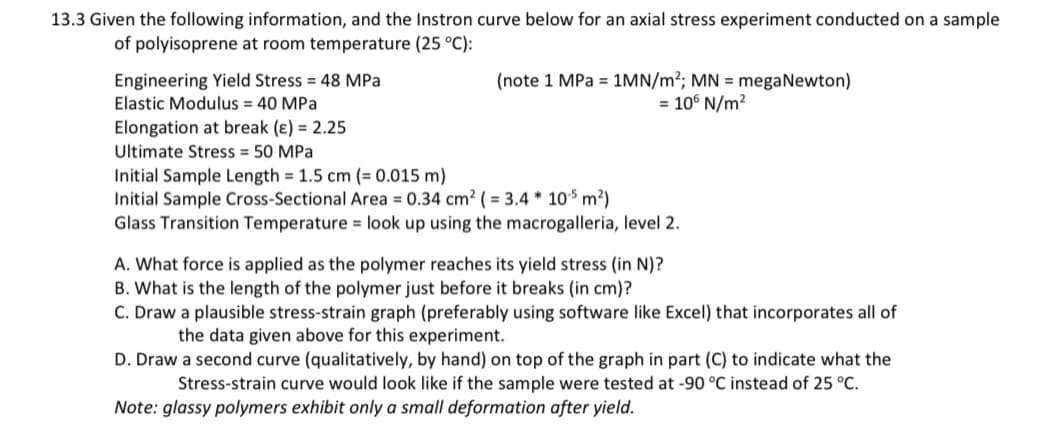13.3 Given the following information, and the Instron curve below for an axial stress experiment conducted on a sample of polyisoprene at room temperature (25 °C): Engineering Yield Stress = 48 MPa Elastic Modulus = 40 MPa Elongation at break (e) = 2.25 Ultimate Stress = 50 MPa (note 1 MPa = 1MN/m²; MN = megaNewton) = 106 N/m² Initial Sample Length = 1.5 cm (= 0.015 m) Initial Sample Cross-Sectional Area = 0.34 cm² ( = 3.4 * 105 m²) Glass Transition Temperature = look up using the macrogalleria, level 2. A. What force is applied as the polymer reaches its yield stress (in N)? B. What is the length of the polymer just before it breaks (in cm)? C. Draw a plausible stress-strain graph (preferably using software like Excel) that incorporates all of the data given above for this experiment. D. Draw a second curve (qualitatively, by hand) on top of the graph in part (C) to indicate what the Stress-strain curve would look like if the sample were tested at -90 °C instead of 25 °C. Note: glassy polymers exhibit only a small deformation after yield.
13.3 Given the following information, and the Instron curve below for an axial stress experiment conducted on a sample of polyisoprene at room temperature (25 °C): Engineering Yield Stress = 48 MPa Elastic Modulus = 40 MPa Elongation at break (e) = 2.25 Ultimate Stress = 50 MPa (note 1 MPa = 1MN/m²; MN = megaNewton) = 106 N/m² Initial Sample Length = 1.5 cm (= 0.015 m) Initial Sample Cross-Sectional Area = 0.34 cm² ( = 3.4 * 105 m²) Glass Transition Temperature = look up using the macrogalleria, level 2. A. What force is applied as the polymer reaches its yield stress (in N)? B. What is the length of the polymer just before it breaks (in cm)? C. Draw a plausible stress-strain graph (preferably using software like Excel) that incorporates all of the data given above for this experiment. D. Draw a second curve (qualitatively, by hand) on top of the graph in part (C) to indicate what the Stress-strain curve would look like if the sample were tested at -90 °C instead of 25 °C. Note: glassy polymers exhibit only a small deformation after yield.
Elements Of Electromagnetics
7th Edition
ISBN:9780190698614
Author:Sadiku, Matthew N. O.
Publisher:Sadiku, Matthew N. O.
ChapterMA: Math Assessment
Section: Chapter Questions
Problem 1.1MA
Related questions
Question

Transcribed Image Text:13.3 Given the following information, and the Instron curve below for an axial stress experiment conducted on a sample
of polyisoprene at room temperature (25 °C):
Engineering Yield Stress = 48 MPa
Elastic Modulus = 40 MPa
Elongation at break (e) = 2.25
Ultimate Stress = 50 MPa
(note 1 MPa = 1MN/m²; MN = megaNewton)
= 106 N/m²
Initial Sample Length = 1.5 cm (= 0.015 m)
Initial Sample Cross-Sectional Area = 0.34 cm² (= 3.4 * 105 m²)
Glass Transition Temperature = look up using the macrogalleria, level 2.
A. What force is applied as the polymer reaches its yield stress (in N)?
B. What is the length of the polymer just before it breaks (in cm)?
C. Draw a plausible stress-strain graph (preferably using software like Excel) that incorporates all of
the data given above for this experiment.
D. Draw a second curve (qualitatively, by hand) on top of the graph in part (C) to indicate what the
Stress-strain curve would look like if the sample were tested at -90 °C instead of 25 °C.
Note: glassy polymers exhibit only a small deformation after yield.
Expert Solution
This question has been solved!
Explore an expertly crafted, step-by-step solution for a thorough understanding of key concepts.
This is a popular solution!
Trending now
This is a popular solution!
Step by step
Solved in 3 steps with 1 images

Knowledge Booster
Learn more about
Need a deep-dive on the concept behind this application? Look no further. Learn more about this topic, mechanical-engineering and related others by exploring similar questions and additional content below.Recommended textbooks for you

Elements Of Electromagnetics
Mechanical Engineering
ISBN:
9780190698614
Author:
Sadiku, Matthew N. O.
Publisher:
Oxford University Press

Mechanics of Materials (10th Edition)
Mechanical Engineering
ISBN:
9780134319650
Author:
Russell C. Hibbeler
Publisher:
PEARSON

Thermodynamics: An Engineering Approach
Mechanical Engineering
ISBN:
9781259822674
Author:
Yunus A. Cengel Dr., Michael A. Boles
Publisher:
McGraw-Hill Education

Elements Of Electromagnetics
Mechanical Engineering
ISBN:
9780190698614
Author:
Sadiku, Matthew N. O.
Publisher:
Oxford University Press

Mechanics of Materials (10th Edition)
Mechanical Engineering
ISBN:
9780134319650
Author:
Russell C. Hibbeler
Publisher:
PEARSON

Thermodynamics: An Engineering Approach
Mechanical Engineering
ISBN:
9781259822674
Author:
Yunus A. Cengel Dr., Michael A. Boles
Publisher:
McGraw-Hill Education

Control Systems Engineering
Mechanical Engineering
ISBN:
9781118170519
Author:
Norman S. Nise
Publisher:
WILEY

Mechanics of Materials (MindTap Course List)
Mechanical Engineering
ISBN:
9781337093347
Author:
Barry J. Goodno, James M. Gere
Publisher:
Cengage Learning

Engineering Mechanics: Statics
Mechanical Engineering
ISBN:
9781118807330
Author:
James L. Meriam, L. G. Kraige, J. N. Bolton
Publisher:
WILEY